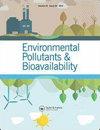Pollution and risk assessment of heavy metals in Zuoxiguo antimony mining area, southwest China
IF 3.2
4区 环境科学与生态学
Q2 BIOCHEMISTRY & MOLECULAR BIOLOGY
Environmental Pollutants and Bioavailability
Pub Date : 2022-12-13
DOI:10.1080/26395940.2022.2156397
引用次数: 10
Abstract
ABSTRACT We collected tailings samples to assess and analyze the concentrations of heavy metals, pollution levels, and the risks posed by heavy metals in the tailings of the Zuoxiguo antimony mine to ecological and human health. The samples were selected by employing the serpentine sampling method, which were treated heavy-metal digestion method. Cu, Cr, Cd, and Pb were determined via inductively coupled plasma mass spectrometry, As and Sb were identified through atomic fluorescence, the average concentration of heavy metals in the tailings is: Sb (5902.77 mg/kg)>As (412.53 mg/kg)>Zn (155.42 mg/kg)>Cr (143.32 mg/kg)>Cu (92.68 mg/kg)>Pb (48.49 mg/kg)>Cd (3.29 mg/kg). The average Nemerow pollution index (NPI) was 553.06, indicating a high level of pollution. The average integrated ecological risk index (RI) result was 5395.94, indicating a serious threat to the study area’s ecology. The Non-carcinogenic health-risk index (HQ) suggested that all heavy metals posed a higher risk to children than to adults under different modes of exposure, with oral intake of Sb and As posing a non-carcinogenic risk to both adults and children, For adults, HQing value of Sb and As are 22.07 and 2.13, respectively; for child, HQing value of Sb and As are 178 and 16.29, which are exceeding limitation of 1. Dermal exposure posing a non-carcinogenic risk to child, for child, HQderm value of Sb and As are 14.96 and 3.32, which are also exceeding limitation of 1. The findings suggest that Sb and As pose serious threats to both the ecological environment and human health and that the local government should focus on Sb and As management for regions.左西国锑矿区重金属污染及风险评价
本文章由计算机程序翻译,如有差异,请以英文原文为准。
求助全文
约1分钟内获得全文
求助全文
来源期刊

Environmental Pollutants and Bioavailability
Chemical Engineering-Chemical Health and Safety
CiteScore
4.30
自引率
3.00%
发文量
47
审稿时长
13 weeks
期刊介绍:
Environmental Pollutants & Bioavailability is a peer-reviewed open access forum for insights on the chemical aspects of pollutants in the environment and biota, and their impacts on the uptake of the substances by living organisms.
Topics include the occurrence, distribution, transport, transformation, transfer, fate, and effects of environmental pollutants, as well as their impact on living organisms. Substances of interests include heavy metals, persistent organic pollutants, and emerging contaminants, such as engineered nanomaterials, as well as pharmaceuticals and personal-care products as pollutants.
 求助内容:
求助内容: 应助结果提醒方式:
应助结果提醒方式:


